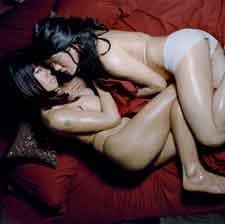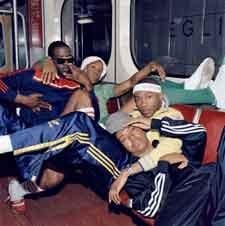
SELF IDENTITIES. Jimm Tran's new show is a hit and miss affair. Some photos, like Two Asian Boys Kissing (2008), are more effective than others. Credit: Couresty of Jimm Tran/jimmmtran.com
I was in a Winnipeg gay bar awhile back, having a drink, when the DJ announced the upcoming drag act was “as exotic as you can get.” Cue the blackfaced queen in a huge blonde fright wig. The effect was confusing, especially when she took off her brown gloves made of pantyhose. Her face was a sweaty mass of dark umber foundation, but her hands were as white as driven snow.
Self Identities, Jimm Tran’s show at A Space (paired by curator Reena Katz with Insoon Ha’s performance installation), is similarly confusing. In a roomful of large-format photographs, Tran performs various gender and racial identities. The result is the kind of sloppy thinking that identity politics is too often associated with.
Various identity drags — gender, racial, cultural — have been a mainstay of a certain kind of artistic practice, and a key conceptual and critical strategy for non-white artists. Of course, the means by which they employ that strategy is crucial.
Take, for example, Ming Wang, who represented Singapore in this year’s Venice Biennale, and who crosses many racial and gender lines. In his Life of Imitation, he has a small group of Singaporean actors restage pivotal scenes from Douglas Sirk’s Imitation of Life and Wong Kar Wai’s In the Mood for Love.
Yasumasa Morimura has made a career of recreating iconic art and cinema moments: He has dragged up most famously as Manet’s Olympia and Marilyn Monroe in The Seven Year Itch. Both Wang and Morimura’s performances have very specific objects, discussing race, cultural and colonial otherness by insinuating themselves (sometimes good-humouredly, sometimes savagely) into the effluvia of mass-culture production.
Tran’s photographs have no such strategy, so it’s unclear what exactly he’s doing or who he’s talking about in his work. His assumption of various East Asian stereotypes becomes muddled as the show progresses. His imagery is rote and simplistic, but at least I can see where he’s going with Androgyne or Two Asian Boys Kissing, where he plays up the image of the smooth, exotic lady boy. I never realized, however, that a fondness for soup is a particular stock-in-trade of Asian identity.
Things become worse when Tran moves into other cultures, donning sari, bindi dot, prosthetic nose and brown-face for Farheen With Pepsi (South Asians love soda?), or thugging it up in blackface and tracksuit in Brothas and Sistas. His concept of Latin cultural stereotypes seems to be limited, again, to props: a giant afro, some dark makeup and a crocheted wall-rug (Latinos love macramé?).
Katz’s curatorial statement hints at Tran’s personal connection to these communities. However, there’s little evidence of those relationships in the photos themselves. Furthermore, his trips to the makeup counter undercut any claims to an authentic personal experience; it remains unclear why he himself must act these parts. Katz interprets the work using the standard buzzwords of colonial theory (“otherness,” “marginal bodies”), which seems overreaching, and fails either to distract from or compensate for Tran’s narrative thoughtlessness.
All told, Tran’s work here seems decidedly undergraduate, as if in response to an assignment on self-portraiture (never mind that these photographs span 10 years). His notions of ethnicity, certainly others’ ethnicities, are vague and one-dimensional, and somewhat baffling in their proposed context of community belonging.
What’s more, the photographs themselves are not terribly exciting: static, stagey compositions; pedestrian use of studio lighting; mercenary use of flash lighting; all of which flattens any sense of campy drama that these oddly po’-faced photographs sorely need. It would all be forgettable, if it weren’t so confusing.

 Why you can trust Xtra
Why you can trust Xtra


